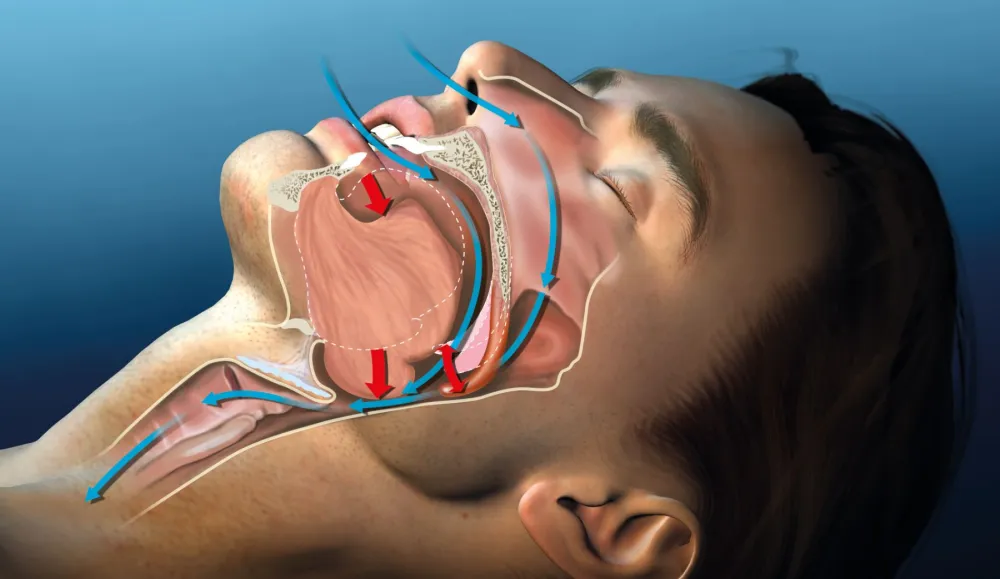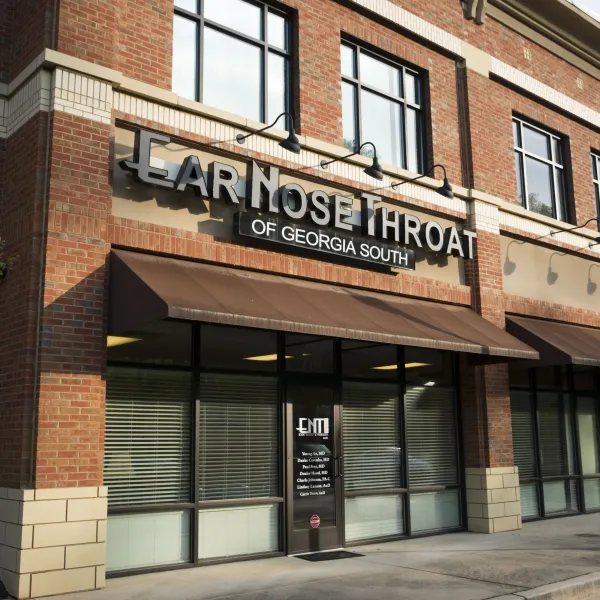
AIRvance Procedure

AIRvance Procedure At ENT of Georgia South
A significant factor in Obstructive Sleep Apnea (OSA) can be the repetitive collapsing of the tongue during sleep, resulting in partial or complete obstruction of the upper airway passage. At ENT of Georgia South, the AIRvance procedure is performed under general anesthesia in an outpatient surgery center or hospital. This procedure offers a new, unique option for patients suffering from sleep apnea due to airway obstruction by the tongue and related structures.
What is the AIRvance Procedure?
The AIRvance THS procedure, formerly known as the Repose System, is an FDA-approved surgical procedure (the original Repose system was cleared in 1998/1999, with the AIRvance Bone Screw System for hyoid suspension receiving clearance in 2013). It is designed to stabilize the tongue and/or hyoid bone, preventing them from collapsing and obstructing the airway during sleep.
OSA often occurs when the muscles in the throat, including the tongue, relax excessively during sleep, allowing gravity to pull them backward and block airflow. The AIRvance procedure addresses this anatomical issue in one or two ways:
Tongue Suspension: This involves inserting a sling-like device, typically made of a durable polypropylene suture anchored by a small titanium screw, under the chin. This "hammock" gently supports the tongue and prevents it from falling backward.
Hyoid Suspension: The hyoid is a U-shaped bone in the neck that supports the tongue base. In some cases, particularly when obstruction also involves tissues lower in the throat, the same AIRvance system can be used to reposition the hyoid bone. Sutures, anchored by tiny titanium screws in the lower jaw (mandible), are looped around the hyoid bone, bringing it slightly forward and upward. This effectively enlarges the airway at the level of the tongue base and hypopharynx.
In many cases of moderate to severe sleep apnea where tongue base and hypopharyngeal collapse are factors, the device is often inserted at both sites to address multiple levels of obstruction.
How Does the AIRvance Procedure Work?
Performed by a specially-trained ENT surgeon specializing in sleep apnea at ENT of Georgia South, the procedure involves making a small incision under the chin.
For Tongue Suspension: Using a specialized delivery device, the surgeon implants a small, sling-like suture that acts like a hammock for the tongue. This suture is held in place by a tiny, biocompatible titanium screw secured to the inside of the lower jawbone. This support keeps your tongue from falling backward and obstructing your airway during sleep.
For Hyoid Suspension: Using a similar approach through the same incision, the surgeon can implant sutures that loop around the hyoid bone (located at the base of the tongue). These sutures are then anchored to tiny titanium screws on the inside of the lower jaw. This repositions the hyoid bone forward and upward, effectively moving the tongue base and surrounding tissues further away from the airway.
The procedure itself typically takes about 30-60 minutes, depending on whether one or both sites (tongue and hyoid) are being treated.
Who is a Good Candidate for the AIRvance Procedure?
The AIRvance procedure may be an excellent option for adults with OSA primarily caused by the tongue base collapsing into the airway, with or without hyoid bone involvement. It is often considered if you:
Have been diagnosed with moderate to severe OSA through a formal sleep study.
Have not found adequate relief with, or are unable to tolerate, other OSA treatments like Continuous Positive Airway Pressure (CPAP) or oral appliances.
Have a specific pattern of airway collapse at the level of the tongue and/or hyoid. This is identified by a thorough examination by your ENT specialist, which may include a procedure called Drug-Induced Sleep Endoscopy (DISE). DISE allows the surgeon to observe your airway behavior during simulated sleep to pinpoint the exact location(s) of obstruction.
Generally, this procedure is considered for patients with a Body Mass Index (BMI) typically below 30-32 kg/m ², as its effectiveness can sometimes be reduced in individuals with higher BMIs where generalized excess tissue might be a larger contributing factor.
The AIRvance procedure is one of several approaches available for treating OSA, alongside CPAP, oral appliances, and other surgical options. Your ENT surgeon at ENT of Georgia South will conduct a comprehensive evaluation to determine if AIRvance is the most appropriate and effective treatment for your specific condition. It is generally not recommended if you have an active infection in the treatment area or certain anatomical features that make it unsuitable.
What are the Advantages of the AIRvance Procedure?
Targeted Treatment: Directly addresses tongue-base and hyoid-related airway obstruction.
Minimally Invasive: Performed through a small incision under the chin.
Quick Procedure: Typically takes about 30-60 minutes.
Fast Recovery: Many patients return to non-strenuous daily activities relatively quickly, with a fuller recovery typically within about a week.
No Significant Change to Outward Facial Appearance: Unlike some traditional jaw repositioning surgeries.
Potentially Long-Lasting Relief: Offers a durable solution for snoring and sleep apnea caused by airway obstruction by the tongue.
Reversible: The procedure is also reversible if needed, which involves a separate surgical procedure to remove the implanted sutures and screws.
What are the Potential Risks and Recovery Like?
Like any surgical procedure, AIRvance carries potential risks, though it is generally considered safe and effective for appropriately selected patients. Your surgeon will discuss these with you in detail. Potential risks include:
Infection at the incision site or around the implant (this is the most common adverse event and may, in some cases, require antibiotics or even removal of the device).
Pain, swelling, or bruising in the area under the chin or in the tongue.
Suture breakage or the screw becoming dislodged, potentially requiring a revision procedure.
Temporary changes in speech (e.g., muffled speech) or swallowing (dysphagia), especially if the hyoid is significantly advanced.
Numbness or, rarely, injury to nerves in the area.
Damage to tooth roots (rare, if screw placement is incorrect).
Recovery:
Following the AIRvance procedure, you can expect some soreness and swelling under your chin and possibly in your tongue for several days to a week. Pain medication will be prescribed or recommended to manage discomfort. You will likely be advised to eat soft foods for a period. Most patients can resume normal, non-strenuous activities within a few days, with a more complete recovery typically taking about one week. Your doctor at ENT of Georgia South will provide detailed post-operative instructions regarding incision care, activity levels, dietary recommendations, and follow-up appointments.
What Results Can I Expect from the AIRvance Procedure?
Results from clinical studies indicate that the AIRvance procedure can provide significant, long-term improvement in the symptoms of snoring and sleep apnea for appropriately selected patients. However, individual results can vary based on your specific anatomy, the severity of your OSA, and other factors.
Clinical studies of the AIRvance THS System (and its predecessor, the Repose system) have shown that patients experienced:
A significant decrease in their Apnea-Hypopnea Index (AHI - a measure of sleep apnea severity) - by as much as 73% in select patient groups.
Long-term "cure" rates (often defined as achieving an Apnea-Hypopnea Index (AHI) below a certain threshold, e.g., <20, and a >50% reduction in AHI) have been reported up to 78% in specific three-year follow-up studies for certain patient populations.
It's important to note that success rates can vary. Success rates are generally higher when AIRvance is part of a comprehensive, multi-level surgical approach if other sites of obstruction are also present.
Less daytime sleepiness and significant improvements in lifestyle, including quality of sleep and energy levels.
It's crucial to have realistic expectations and discuss the likely outcomes for your specific situation with your surgeon. Follow-up sleep studies may be recommended several months after the procedure to objectively measure the improvement in your OSA.
Take the first step towards a better night's sleep and a healthier lifestyle for you and your bed partner. Make an appointment at ENT of Georgia South for an evaluation today.
Our Convenient
Office Locations



Buckhead
1218 W Paces Ferry Rd NW
UNIT 208
Atlanta, GA 30327
Monday - Thursday 8am - 4:30pm
Friday - 8am-2:30pm
